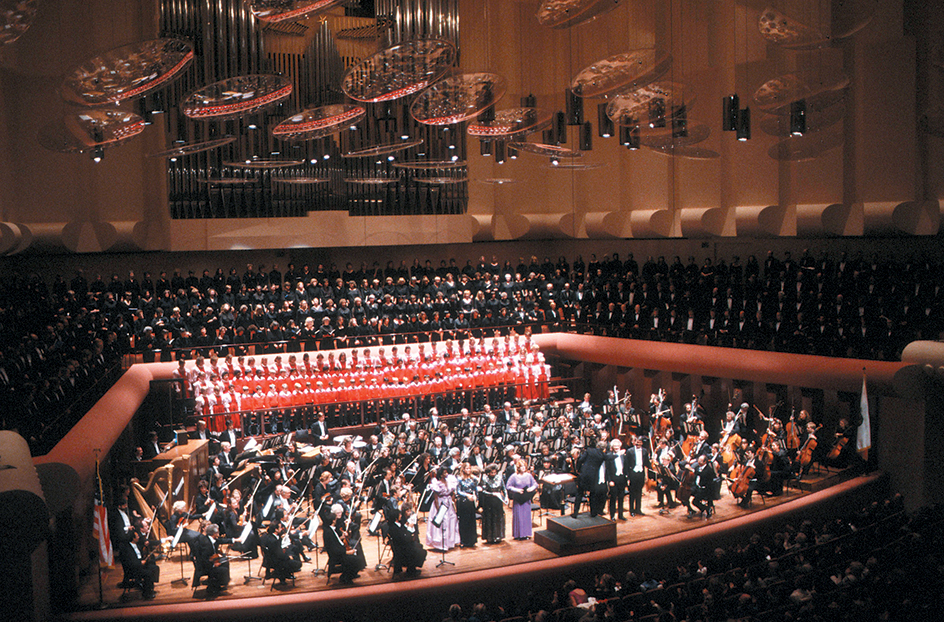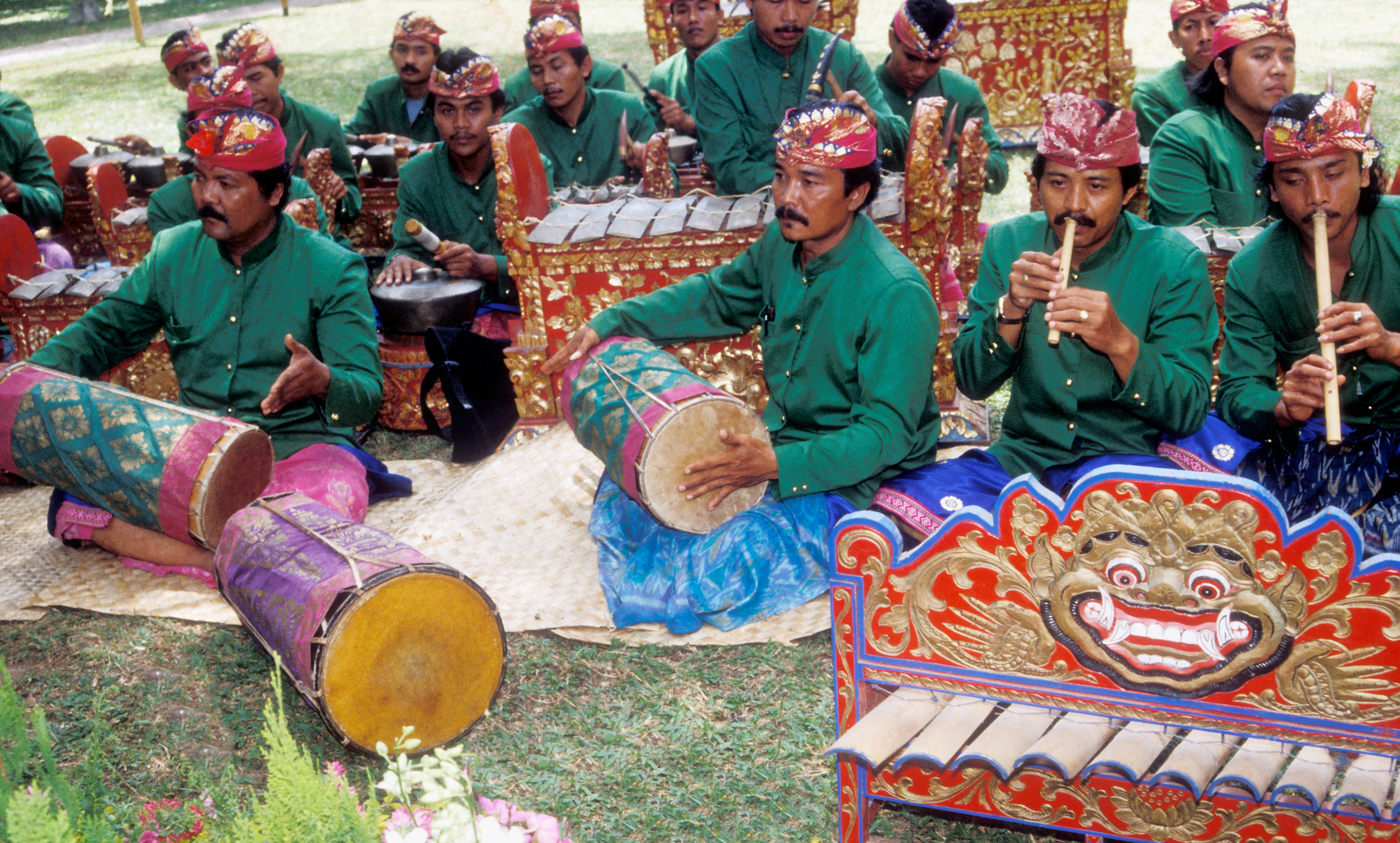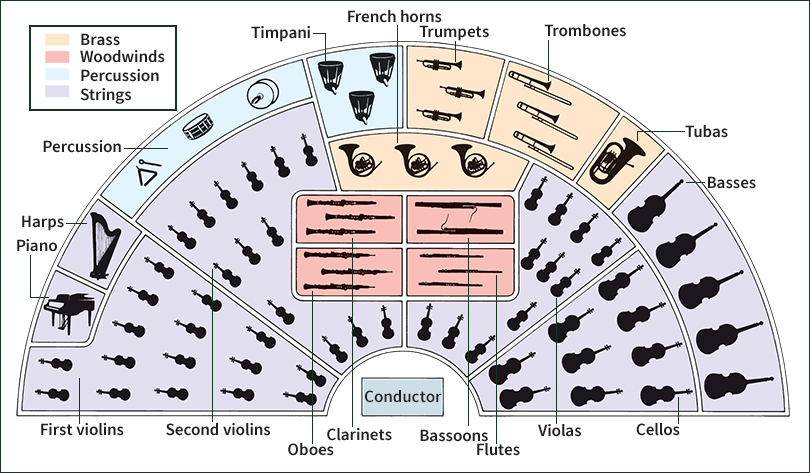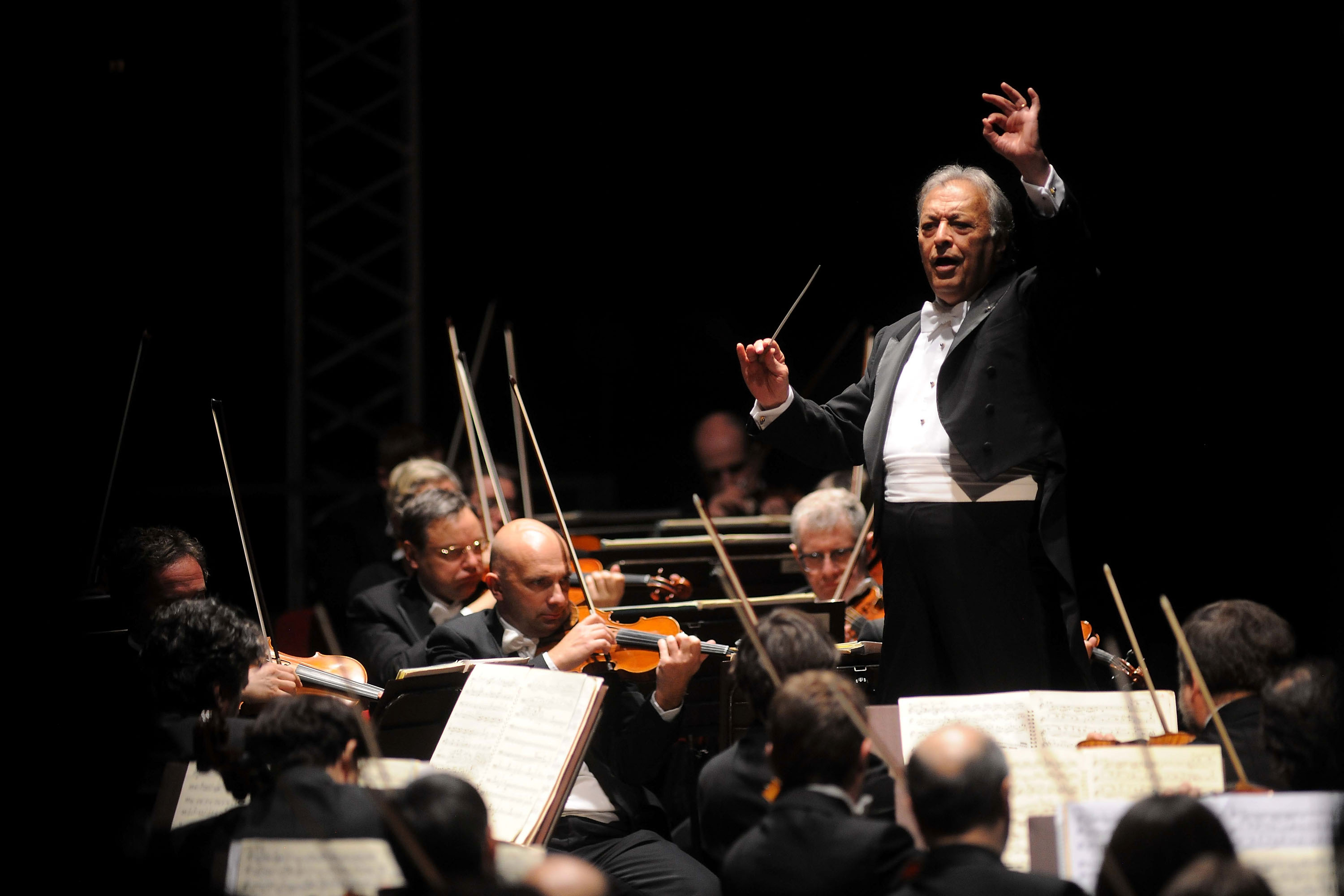Orchestra is a group of musicians who play together on various instruments. Some African and Asian orchestras consist entirely of percussion instruments, such as drums, gongs, and xylophones. But in most Western nations, a musical group is considered an orchestra only if it includes violins and other stringed instruments. An orchestra differs from a band, which consists chiefly of wind and percussion instruments.

Some orchestras, called string orchestras, have only stringed instruments. On the other hand, dance orchestras resemble bands in most ways but may include a small string section. The word orchestra generally refers to a symphony orchestra, which consists mainly of stringed instruments. Symphony orchestras also have woodwind, brass, and percussion instruments, which enable them to produce a full range of musical sounds.
Symphony orchestras play all types of music, but most of them specialize in classical works. An orchestra may perform alone, or it may accompany one or more instrumental or vocal soloists or a chorus. Orchestras also accompany ballets and operas and provide background music for motion pictures and television productions.


Some symphony orchestras are made up entirely of professional musicians. Most of the world’s major cities have a professional symphony, and some cities have several. They include such large, well-known orchestras as the Berlin Philharmonic, Boston Symphony, Chicago Symphony, and London Symphony orchestras; the New York Philharmonic; the Philadelphia Orchestra; and the Vienna Philharmonic. Many smaller communities, especially in Western countries, also have a symphony orchestra. These orchestras consist chiefly of amateur musicians. Many schools in Western countries have student orchestras.
The structure of a symphony orchestra
Orchestral music is written in the form of a score, which shows the notes to be played by each instrument. Most scores call for about the same kinds of instruments, and so most orchestras have a similar structure. A typical orchestra has about 20 kinds of instruments, but the number of each varies among different groups. A large orchestra may have more than 100 musicians, and small orchestras have from about 15 to 40 players. The small groups are often called chamber orchestras. During a performance, only the conductor follows the complete score. The printed music used by the musicians shows only their individual parts.
The musicians
are divided into four main groups called sections: (1) the string section, (2) the woodwind section, (3) the brass section, and (4) the percussion section. The various instruments in the string, woodwind, and brass sections are pitched in different ranges, like the voices in a chorus. In the following discussion, the instruments in each of these sections are listed in order from those of the highest range to those of the lowest. Some percussion instruments are also tuned to definite pitches, but most of them have an indefinite pitch.

The string section
is the heart of a symphony orchestra. It has more than half the musicians and consists of from 20 to 32 violins, 8 to 10 violas, 8 to 10 cellos, and 6 to 10 string basses. The violinists are divided into two groups of equal size. The first violins play the highest-pitched part in the string section, and the second violins play the next highest part. The leading first violinist serves as concertmaster of the orchestra. The concertmaster directs the other musicians in tuning their instruments and may also be the orchestra’s assistant conductor.
Loading the player...Cello
The woodwind section
consists chiefly of flutes, oboes, clarinets, and bassoons. An orchestra has from 2 to 4 of each of these instruments. The musicians in the section also play various other woodwind instruments when a score requires them to do so. For example, a flutist may switch to the piccolo, and an oboe player may double on the English horn.
Loading the player...Bassoon
The brass section
consists of 2 to 5 trumpets, 2 to 8 French horns, 2 to 4 trombones, and 1 tuba.
Loading the player...French horn
The percussion section
includes two or more timpani, or kettle drums; bells and cymbals; wood blocks; and a bass drum, gong, snare drum, triangle, tambourine, and xylophone.
Loading the player...Kettledrum
Other instruments
are added to an orchestra if a score calls for them. They include such instruments as the harp, harpsichord, organ, piano, synthesizer, and various saxophones.
Loading the player...Harp
The conductor
directs the musicians by keeping time with the baton or with his or her hands, and by means of gestures and facial expressions. However, conductors do their most important work before a performance—and even before rehearsing a composition. In most cases, the conductor selects the music to be played at a concert. After selecting a work, the conductor’s first job is to interpret the music by deciding exactly how it should be played. Interpretation of a work includes such elements as tempo, tonal quality, and phrasing. After determining these features of the score, the conductor rehearses the music with the players.

During a rehearsal, the conductor asks individual musicians or sections to play various parts of the score again and again until the desired effect has been achieved. He or she strives for the correct balance among the many instruments playing at the same time and adjusts the sound to suit the acoustics of the performance hall. The finest conductors are respected not only for their musical skill but also for their ability to inspire both musicians and audiences.
Most conductors also help audition musicians who apply for positions in an orchestra. A conductor listens to the applicants perform and then recommends who should be invited to join.
Orchestra management.
Most major orchestras in the United States are operated by private, nonprofit corporations called symphony societies. The chief concern of a symphony society is to raise funds to help support the orchestra. The board of directors of the society also acts on the conductor’s recommendations regarding musicians to be offered positions in the orchestra.
Most professional orchestras have a business manager to handle most of the administrative work. The business manager works out the orchestra’s budget; prepares employment contracts; plans rehearsal, concert, and recording schedules; and organizes ticket sales and publicity.
History
The term orchestra was first used by the ancient Greeks for the front area of a stage. During the Middle Ages, orchestra came to mean the musicians on that part of the stage. In modern times, orchestra has come to mean both the musicians on stage and the seats directly in front of the stage.
Beginnings.
The first orchestras were organized at the royal court of France and in Italian churches and palaces during the late 1500’s and the 1600’s. At first, orchestras served chiefly to accompany social dances, ballets, religious vocal music, and operas. Most of these orchestras consisted mainly of string instruments. In Germany, wind instruments were also popular. Except in France, these orchestras had no standard structure. String, wind, and percussion instruments were often mixed. The orchestra of King Louis XIII of France was the first standardized orchestra. It had 24 instruments of the violin family, divided into five sections, and 12 wind instruments. Beginning in the 1600’s, most orchestras also played a bass line called a basso continuo, usually with a lute, harp, organ, or harpsichord.
The 1700’s and 1800’s.
By the early 1700’s, some European composers also began to write music for orchestra in its own right. These composers included Johann Sebastian Bach, Arcangelo Corelli, George Frideric Handel, and Antonio Vivaldi. Their compositions were called concerti, concerti grossi, overtures, and suites.
Orchestral works called symphonies first appeared as overtures or small instrumental interludes in operas about 1600. By the 1720’s and 1730’s Giovanni Battista Sammartini began to write independent string symphonies in Italy. In the late 1700’s, Joseph Haydn and Wolfgang Mozart, perfected the classical symphony. The clarinet became standard in the symphony orchestra in the 1790’s. In the early 1800’s, Ludwig van Beethoven composed the first symphonies that included trombones and voices.
During the 1800’s, cities began to take over patronage of orchestras. Many orchestras were regularly engaged in accompanying operas in municipal opera houses and also played concerts on the side. A few, however, were established independently of the opera. The Gewandhaus Orchestra of Leipzig, Germany, is the oldest orchestra still playing. It was founded in 1781. The Paris Conservatory Orchestra was established in 1800, and what is now the Royal Philharmonic Society was founded in 1813.
Until the early 1800’s, orchestras were small enough to perform without a conductor. The concertmaster or a keyboard player in the basso continuo served as the leader. By 1830, orchestras had grown so large that nearly all were led by a conductor. Composers Hector Berlioz and Felix Mendelssohn were among the earliest conductors. Berlioz was one of the first to conduct with a baton.
Popular types of orchestral music in the 1800’s included symphonies, overtures, symphonic poems, and concertos. Orchestras also continued to accompany opera, ballet, and religious music. In the late 1800’s and early 1900’s, such composers as Richard Wagner, Anton Bruckner, Gustav Mahler, and Richard Strauss wrote works for orchestras of 100 or more musicians.
Loading the player...Symphony No. 6
Modern orchestras.
Since the early 1900’s, there has been renewed interest in works for smaller orchestras. Some composers have added electronic instruments or reorganized the orchestra into groups to create new kinds of musical sounds. Today, most large orchestras have several conductors on their staffs.
The symphony orchestra originated in Europe, but its form has been copied throughout the world. There are now many symphony orchestras in non-European countries including Argentina, Australia, Brazil, China, Israel, Japan, and Mexico. The first orchestras in the United States were formed in the late 1700’s. The oldest American orchestra still performing is the student orchestra at Harvard University, formed in 1808. Important American orchestras include the New York Philharmonic (1842), the Boston Symphony (1881), the Chicago Symphony (1891), and the Philadelphia Orchestra (1900).
The cost of maintaining an orchestra has increased dramatically since the mid-1900’s. The income from ticket sales pays only a fraction of an orchestra’s expenses. Many European orchestras rely heavily on funds from government sources. In the United States, many orchestras receive additional funds from both private and public sources and from recording royalties. Organizations such as the National Endowment for the Arts, an independent federal agency, distribute funds to symphony societies. Some orchestras have sought other sources of funding in new types of programming. For example, they have provided background music for movies, radio, and videos.
